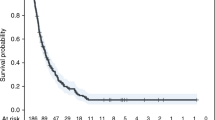Abstract
Purpose
Distant metastasis (DM) of head and neck squamous cell carcinoma (HNSCC) is not common but remains a substantial problem. Here, we evaluated factors predictive of long-term survival in HNSCC patients presenting with DM after initial definitive treatment.
Methods
The medical records of patients with HNSCC who underwent definitive treatment between 2006 and 2011 were reviewed. Univariate and multivariate analyses were performed to identify clinicopathological factors associated with long-term survival after DM.
Results
Of 779 HNSCC patients, 98 (12.6 %) had DM after completion of definitive treatment, with a median time to DM of 15 months (range 1–87 months). Overall survival (OS) rates at 1 and 2 years after DM were 43.1 and 20.5 %, respectively. In multivariate analysis, hypoalbuminemia (P < 0.001, hazard ratio [HR] 3.45, 95 % confidence interval [CI] 2.01–5.92), prior or simultaneous locoregional failure events (P < 0.001, HR 2.36, 95 % CI 1.47–3.79), multisite DM (P = 0.001, HR 2.30, 95 % CI 1.42–3.72), and no salvage treatment for DM (P = 0.003, HR 2.19, 95 % CI 1.32–3.64) were independent predictors of OS after the development of DM. Seventeen (18 %) patients survived >2 years. Patients who did not have any of these risk factors had the most favorable outcomes, with a 2-year survival of 100 %.
Conclusions
In the absence of risk factors, long-term survival can be achieved despite the development of DM after definitive treatment.


Similar content being viewed by others
References
Adelstein DJ, Leblanc M (2006) Does induction chemotherapy have a role in the management of locoregionally advanced squamous cell head and neck cancer? J Clin Oncol 24:2624–2628
Ang KK et al (2001) Randomized trial addressing risk features and time factors of surgery plus radiotherapy in advanced head-and-neck cancer. Int J Radiat Oncol Biol Phys 51:571–578
Argiris A, Karamouzis MV, Raben D, Ferris RL (2008) Head and neck cancer. Lancet 371:1695–1709
Charlson ME, Pompei P, Ales KL, Mackenzie CR (1987) A new method of classifying prognostic comorbidity in longitudinal studies: development and validation. J Chr Dis 40:373–383
Chen TC et al (2013) The clinical predictive factors for subsequent distant metastasis in patients with locoregionally advanced oral squamous cell carcinoma. Oral Oncol 49(4):367–373
Dragovic AF, Caudell JJ, Spencer SA, Carroll WR, Nabell LA, Bonner JA (2013) Locoregional failure and the risk of distant metastasis after modern radiotherapy for head and neck cancer. Head Neck 35:381–387
Edge SB, Byrd DR, Compton CC, Fritz AG, Greene FL, Trotti A (2010) AJCC Cancer Staging Manual, 7th edn. NY, Springer, New York, pp 21–78
Haddad RI, Shin DM (2008) Recent advances in head and neck cancer. N Engl J Med 359:1143–1154
Hellman S (1994) Karnofsky Memorial Lecture. Natural history of small breast cancers. J Clin Oncol 12:2229–2234
Huang SH et al (2013) Natural course of distant metastases following radiotherapy or chemoradiotherapy in HPV-related oropharyngeal cancer. Oral Oncol 49:79–85
Jemal A, Bray F, Center MM, Ferlay J, Ward E, Forman D (2011) Global cancer statistics. CA Cancer J Clin 61:69–90
Kim JW et al (2013) (18)F-FDG PET/CT surveillance at 3-6 and 12 months for detection of recurrence and second primary cancer in patients with head and neck squamous cell carcinoma. Br J Cancer 109:2973–2979
Kramer S, Marcial VA, Pajak TF, MacLean CJ, Davis LW (1986) Prognostic factors for loco/regional control and metastasis and the impact on survival. Int J Radiat Oncol Biol Phys 12:573–578
Leon X, Quer M, Orus C, Del Prado Venegas M, Lopez M (2000) Distant metastases in head and neck cancer patients who achieved loco-regional control. Head Neck 22:680–686
Liao CT et al (2007) Analysis of risk factors for distant metastases in squamous cell carcinoma of the oral cavity. Cancer 110:1501–1508
McBride SM, Busse PM, Clark JR, Wirth LJ, Ancukiewicz M, Chan AW (2014) Long-term survival after distant metastasis in patients with oropharyngeal cancer. Oral Oncol 50:208–212
Shiono S et al (2009) Pulmonary metastasectomy for pulmonary metastases of head and neck squamous cell carcinomas. Ann Thorac Surg 88:856–860
Siegel R, Ma J, Zou Z, Jemal A (2014) Cancer statistics, 2014. CA Cancer J Clin 64:9–29
Vermorken JB et al (2008) Platinum-based chemotherapy plus cetuximab in head and neck cancer. N Engl J Med 359:1116–1127
Wedman J et al (1996) Value of resection of pulmonary metastases in head and neck cancer patients. Head Neck 18:311–316
Winter H et al (2008) Does surgical resection of pulmonary metastases of head and neck cancer improve survival? Ann Surg Oncol 15:2915–2926
Xu GZ, Guan DJ, He ZY (2011) (18)FDG-PET/CT for detecting distant metastases and second primary cancers in patients with head and neck cancer. A meta-analysis. Oral Oncol 47:560–565
Yao M et al (2012) Distant metastases in head-and-neck squamous cell carcinoma treated with intensity-modulated radiotherapy. Int J Radiat Oncol Biol Phys 83:684–689
Yi JS et al (2012) 18F-FDG PET/CT for detecting distant metastases in patients with recurrent head and neck squamous cell carcinoma. J Surg Oncol 106:708–712
Acknowledgments
This study was supported by a Grant (No. 2014-0306) from the Asan Institute for Life Science and a Grant (HI14C23050000) from the Korean Health Technology R&D Project, Ministry of Health and Welfare, Seoul, Republic of Korea (J.-L. Roh).
Author information
Authors and Affiliations
Corresponding author
Ethics declarations
Conflict of interest
The authors have no conflict of interests to disclose.
Electronic supplementary material
Below is the link to the electronic supplementary material.
Rights and permissions
About this article
Cite this article
Kang, HS., Roh, JL., Kim, MJ. et al. Predictive factors for long-term survival in head and neck squamous cell carcinoma patients with distant metastasis after initial definitive treatment. J Cancer Res Clin Oncol 142, 295–304 (2016). https://doi.org/10.1007/s00432-015-2043-x
Received:
Accepted:
Published:
Issue Date:
DOI: https://doi.org/10.1007/s00432-015-2043-x




